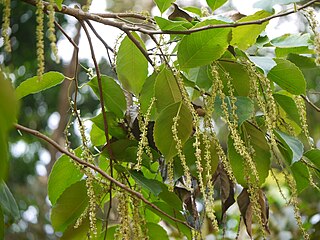
Royal Botanic Gardens, Kew is a non-departmental public body in the United Kingdom sponsored by the Department for Environment, Food and Rural Affairs. An internationally important botanical research and education institution, it employs 1,100 staff. Its board of trustees is chaired by Dame Amelia Fawcett.

Citrus is a genus of flowering trees and shrubs in the family Rutaceae. Plants in the genus produce citrus fruits, including important crops such as oranges, mandarins, lemons, grapefruits, pomelos, and limes.

The tangerine is a type of citrus fruit that is orange in color, that is considered either a variety of Citrus reticulata, the mandarin orange, or a closely related species, under the name Citrus tangerina, or yet as a hybrid of mandarin orange varieties, with some pomelo contribution.

Buchanania is a genus of plants in the mango and cashew family Anacardiaceae, native to areas from India to southern China, and southwards to northern Australia and the western Pacific.

Homalium is a genus of plants in the family Salicaceae.

Hopea is a genus of plants in the family Dipterocarpaceae. It contains some 113 species, distributed from Sri Lanka and southern India to the Andaman Islands, Myanmar, southern China, and southward throughout Malesia to New Guinea. They are mainly main and subcanopy trees of lowland rainforest, but some species can become also emergent trees, such as Hopea nutans.

Ixonanthes reticulata is a species of plant in the Ixonanthaceae family. It is native to an area from China to India to mainland and maritime Southeast Asia. It is a broadleaf evergreen.

Pseuduvaria is a genus of the plant family Annonaceae and tribe Miliuseae: with a native range is Tropical Asia.

The family Apodanthaceae comprises about 10 species of endoparasitic herbs. They live in the branches or stems of their hosts, emerging only to flower and fruit. The plants produce no green parts and do not carry out any photosynthesis. There are two genera: Pilostyles and Apodanthes. A third genus, Berlinianche, was never validly published. Mitochondrial and nuclear DNA sequences confidently place the Apodanthaceae in the Cucurbitales, where they also fit well in terms of their flower morphology. The native range of Apodanthes is restricted to Central and tropical South America, while Pilostyles has a much wider though disjointed native range, encompassing many countries in tropical and subtropical America, a section of Africa from Gabon to Tanzania and down to Zimbabwe, as well as Turkey, Iran, Iraq, and Western Australia.

Iris reticulata, the netted iris or golden netted iris, is a species of flowering plant in the family Iridaceae. It is native from eastern Turkey to Iran, but cultivated widely in temperate regions. The reticulata group of irises is characterised by a fibrous net surrounding the bulb. They are small plants to 15 centimetres (5.9 in), with tubular, sharply-pointed, ribbed leaves, and flowers of yellow, blue or purple with an orange blaze on the falls, appearing in early spring. They are hardy, but prefer a well-drained sunny position in soil which dries out in summer; they are therefore suitable for a rock or gravel garden.
Barringtonia reticulata is a plant in the family Lecythidaceae. The specific epithet reticulata means 'like a network', referring to the leaf veins.

Dicrastylis is a genus of plants in the Lamiaceae, first described in 1855. The entire genus is endemic to Australia. The type species is Dicrastylis fulva.

Rhigospira is a genus of flowering plants in the family Apocynaceae, first described as a genus in 1878 by John Miers. The species, Rhigospira quadrangularis was first described as Ambelania quadrangularis by Johannes Müller Argoviensis in 1860 but was transferred to the genus, Rhigospira, in 1878 by John Miers. The genus contains only one known species, Rhigospira quadrangularis, native to northwestern South America.

Miquelia is a genus of plants in the family Icacinaceae found in tropical India, Southeast Asia, and the Philippines.

World Flora Online is an Internet-based compendium of the world's plant species.

Orobanche reticulata is a species of broomrape known by the common name thistle broomrape. It is a parasitic plant whose host is normally the creeping thistle. It is native to the lowlands of Western Europe and Central Asia, but in the United Kingdom it is a rare and protected plant, growing only in Yorkshire, on grassland sites such as Quarry Moor.
Iodes is a genus of flowering plants belonging to the family Icacinaceae.
Lauridia is a genus of flowering plants belonging to the family Celastraceae.

Haworthia reticulata is a species of succulent plant native to the southwestern Cape Provinces of South Africa. The species has several varieties, including var. hurlingii which is the smallest at up to 1 inch (2.5 cm) wide.

Wisteriopsis reticulata is a species of flowering plant in the family Fabaceae, native to mainland China, Hainan, Taiwan and Vietnam. It was first described by George Bentham in 1852 as Millettia reticulata. Anne M. Schot moved it to Callerya reticulata in 1994, then as a result of a molecular phylogenetic study in 2019, it was moved to the newly created genus Wisteriopsis. It has become naturalized in parts of Florida and Japan.
















